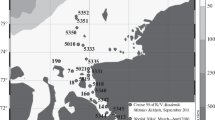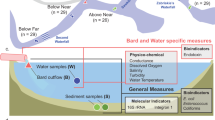Abstract
Time series analysis of heterotrophic baeterial viable counts on agar plates incubated at 20° and 4°C from weekly river water samples for 1 year has revealed a periodicity of 6 to 7 weeks in the total numbers. A cycle of increase and decrease in the counts which could not be attributed to season, river water temperature, pH, and flow rate has been observed in the heterotrophic bacteria which were isolated from river water samples. Spectral analysis has demonstrated a hidden periodicity in population increase and decrease which could not be detected by examination of the raw count data. Fluctuations with periodicity could imply that this is the expected behaviour in a well-balanced ecosystem.
Pseudomonas fluorescens, the predominant species isolated from a river water sample which was at 0°C at the time of sampling, utilized two different pathways at 5° and 30°C. In addition, 2-ketogluconate, a product of the utilization of glucose, was utilized by the same organism. Fluctuations in enzymic responses could contribute to the overall periodicity in bacterial numbers. The flexibility in bacterial metabolism would serve to maintain P. fluorescens in the predominant flora. A feature which sustains health in this ecosystem, P. fluorescens, is one of the most successful of all biodegraders in the aquatic system.
Similar content being viewed by others
References
BellC. R., M. A.Holder-Franklin & M.Franklin, 1980. Heterotrophic bacteria in two Canadian rivers. I. Seasonal variations in the predominant bacterial populations. Water Res. 14: 449–460.
BellC. R., M. A.Holder-Franklin & M.Franklin, 1982. Correlations between predominant heterotrophic bacteria and physico-chemical water quality parameters in two Canadian rivers. Appl. Environ. Microbiol. 43: 269–283.
Chalifour, M. J. & M. A. Holder-Franklin, 1981. Methods of studying population shifts in aquatic bacteria in response to environmental change. In: Environment Canada Scientific Series 124, Inland Waters Directorate, pp. 16–23.
ChatfieldC. 1975. The Analysis of Time Series: Theory and Practice. Chapman & Hall (London), Wiley, New York, 263 pp.
ChatfieldC., 1985. The Analysis of Time Series: An Introduction. 3rd edn. Chapman and Hall. London, New York, 286 pp.
ChatfieldC. & M. P. G.Pepper, 1971. Time Series Analysis: An example from geophysical data. Appl. Stat. 20: 217–238.
CollinsV. G. & L. G.Willoughby, 1962. The distribution of bacterial and fungal spores in Blenham Tarn with particular inference to an experimental overturn. Arch. Microbiol. 43: 294–307.
FryJ. C., N. C. B.Humphrey & T. C.Iles, 1981. Time series analysis for identifying cyclic components in microbiological data. J. Appl. Bacteriol. 50: 189–224.
Holder-Franklin, M. A., 1981. Methods of studying population shifts in aquatic bacteria in response to environmental change. Environment Canada Scientific Series 124. Inland Waters Directorate, 106 pp.
Holder-FranklinM. A., 1992. Aquatic microorganisms: processes, populations and molecular solutions to environmental problems. J. Aquat. Ecosyst. Health 1: 31–40.
Holder-FranklinM. A. & L. J.Wuest, 1983. Population dynamics of aquatic bacteria in relation to environmental change as measured by factor analysis. J. Microbiol. Meth. 1: 209–227.
Holder-Franklin, M. A., L. J. Wuest & M. Franklin, 1980. Oscillations in Bacterial Viable Counts as revealed by Time Series Analysis. Abstr. Ann. Meeting American Society for Microbiology. N 61.
Holder-FranklinM. A., A.Thorpe & L. J.Wuest, 1992. Evaluation of tests employed in the numerical taxonomy of river bacteria. J. Microbiol. Meth. 15: 263–277.
KoopmansL. H., 1974. The spectral Analysis of Time Series. Academic Press, New York.
KreigN. R. & J. B.Holt (eds), 1984. Bergey's Manual of Systematic Bacteriology. Volume 1, Williams and Wilkins, Baltimore.
LynchW. H. & M.Franklin, 1978a. Effects of temperature on diauxic growth with glucose and organic acids. Arch. Microbiol. 118: 133–140.
LynchW. H. & M.Franklin, 1978b. Effect of temperature on the uptake of glucose, gluconate and 2-ketogluconate by Pseudomonas fluorescens. Can. J. Microbiol. 24: 56–62.
LynchW. H., J.McLeod & M.Franklin, 1975. Effects of growth temperature on the accumulation of glucose oxidation products in Pseudomonas fluorescens. Can. J. Microbiol. 21: 1553–1559.
WhitingP. H., M.Midgley & E. A.Dawes, 1976a. The role of glucose limitation in the regulation of the transport of glucose, gluconate and 2-oxogluconate, and of glucose metabolism in Pseudomonas aeruginosa. J. Gen. Microbiol. 92: 304–310.
WhitingP. H., M.Midgley & E. A.Dawes, 1976b. The regulation of transport of glucose, gluconate and 2-oxogluconate of glucose catabolism in Pseudomonas aeruginosa. Biochem. J. 154: 659–668.
Author information
Authors and Affiliations
Rights and permissions
About this article
Cite this article
Holder-Franklin, M.A., Franklin, M. River bacteria time series analysis: a field and laboratory study which demonstrates aquatic ecosystem health. Journal of Aquatic Ecosystem Health 2, 251–259 (1993). https://doi.org/10.1007/BF00044029
Issue Date:
DOI: https://doi.org/10.1007/BF00044029




